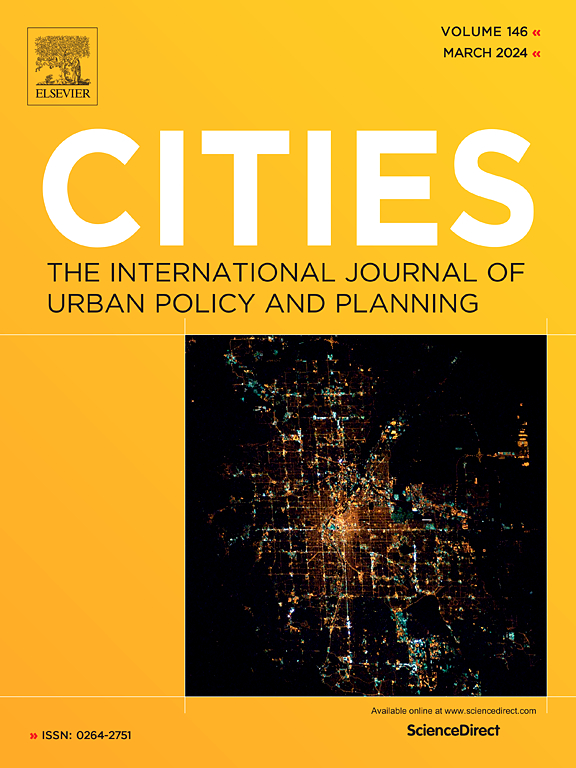A perception-powered urban digital twin to support human-centered urban planning and sustainable city development
IF 6
1区 经济学
Q1 URBAN STUDIES
引用次数: 0
Abstract
Urban Digital Twins (UDTs) offer a promising avenue for advancing sustainable urban development by mirroring physical environments and complex urban dynamics. Such technology enables urban planners to predict and analyze the impacts of various urban scenarios, addressing a global priority for sustainable urban environments. However, their potential in public engagement for environmental perception remains unfulfilled, with existing research lacking the capability to analyze urbanscapes' visual features and predict public perceptions based on photo-realistic renderings. To fill the gap, our study developed and implemented a UDT platform designed for the dual purposes of objective feature evaluation and subjective visual perception, alongside the prediction of perceptions in simulated scenarios. We incorporated DeepLabV3, a deep learning model for imagery semantic segmentation, to quantify a series of visual features within the built environment, such as the proportion of vegetation and architectural elements. Subjective visual perceptions (e.g. safety and lively) are captured using immersive virtual reality to gather public perceptions of different scenarios and learn patterns. Further, utilizing a photo-realistic rendering engine, high-quality renderings of textures and materials for UDT were achieved, and we proved their veracity based on a perception experiment. Afterwards, we employ the random forest algorithm for automated perception predictions of rendering scenarios. The implementation was demonstrated with a case study on an urban greenway in the central area of Singapore. We compared both the objective evaluation and subjective perception results, followed by a demonstration of automated visual perception prediction through photo-realistic scenario simulations, such as modifying vegetation density or introducing new architectural elements to the skyline, to predict the perception of scenarios before they are built, leading to more efficient and automated urban planning.
感知驱动的城市数字孪生系统,支持以人为本的城市规划和可持续城市发展
城市数字孪生体(UDTs)通过镜像物理环境和复杂的城市动态,为推进城市可持续发展提供了一个前景广阔的途径。这种技术使城市规划者能够预测和分析各种城市情景的影响,从而解决全球可持续城市环境的首要问题。然而,这些技术在公众参与环境感知方面的潜力仍未得到发挥,现有研究缺乏分析城市景观视觉特征的能力,也无法根据照片效果图预测公众感知。为了填补这一空白,我们的研究开发并实施了一个 UDT 平台,旨在实现客观特征评估和主观视觉感知的双重目的,同时预测模拟场景中的感知。我们将用于图像语义分割的深度学习模型 DeepLabV3 纳入其中,以量化建筑环境中的一系列视觉特征,如植被和建筑元素的比例。利用沉浸式虚拟现实技术捕捉主观视觉感知(如安全性和生动性),以收集公众对不同场景的感知并学习模式。此外,我们还利用逼真的渲染引擎,为无损检测实现了高质量的纹理和材料渲染,并通过感知实验证明了其真实性。之后,我们采用随机森林算法对渲染场景进行自动感知预测。我们以新加坡中部地区的一条城市绿道为案例进行了演示。我们比较了客观评价和主观感知结果,随后通过照片逼真的场景模拟演示了自动视觉感知预测,例如修改植被密度或在天际线上引入新的建筑元素,从而在场景建成之前预测其感知,从而实现更高效、更自动化的城市规划。
本文章由计算机程序翻译,如有差异,请以英文原文为准。
求助全文
约1分钟内获得全文
求助全文
来源期刊

Cities
URBAN STUDIES-
CiteScore
11.20
自引率
9.00%
发文量
517
期刊介绍:
Cities offers a comprehensive range of articles on all aspects of urban policy. It provides an international and interdisciplinary platform for the exchange of ideas and information between urban planners and policy makers from national and local government, non-government organizations, academia and consultancy. The primary aims of the journal are to analyse and assess past and present urban development and management as a reflection of effective, ineffective and non-existent planning policies; and the promotion of the implementation of appropriate urban policies in both the developed and the developing world.
 求助内容:
求助内容: 应助结果提醒方式:
应助结果提醒方式:


